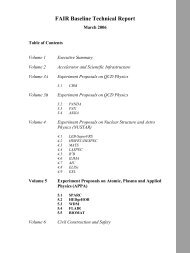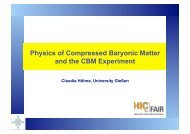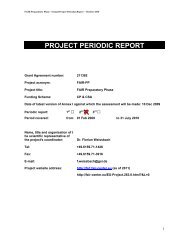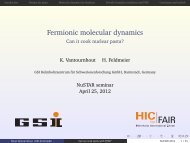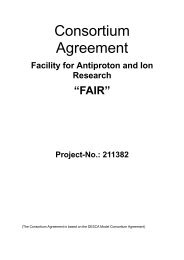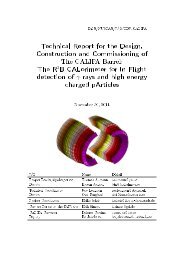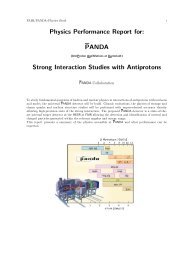NeuLAND - FAIR
NeuLAND - FAIR
NeuLAND - FAIR
You also want an ePaper? Increase the reach of your titles
YUMPU automatically turns print PDFs into web optimized ePapers that Google loves.
B. Neutron MRPC Results in Details<br />
The final <strong>NeuLAND</strong> design is based on a fully active detector of organic scintillator<br />
material. However, in the past also an alternative scheme using passive converters and<br />
a multigap resistive plate chamber (MRPC) based detector had been investigated in<br />
detail, including the construction and test of a fully operational 2 m long prototype.<br />
The scintillator-based design shows significantly better performance than the MRPC option,<br />
therefore it is adopted for the technical design of <strong>NeuLAND</strong>. The present appendix<br />
summarizes the main results of the MRPC studies for reference.<br />
B.1. Principle of Operation of an MRPC-Based Neutron<br />
Detector with a Thick Iron Converter<br />
The principle of operation for an MRPC-based neutron detector is derived from the<br />
existing Large Area Neutron Detector (LAND) [Bla-92] at GSI, which has a face size of<br />
2×2 m 2 . LAND converts neutrons into charged particles in 5 mm thick iron plates, and<br />
subsequently detects the charged particles in plastic scintillators of the same thickness.<br />
With LAND, typical detection efficiencies above 90% have been reached for 400 MeV<br />
neutrons [Bor-03], see sections 4.2 and 4.1.2 for details.<br />
Detectors that are similar to LAND have been used elsewhere, e.g. at Forschungszentrum<br />
Jülich [Roz-05] and with the MONA detector at Michigan State University [Bau-05]. It<br />
should be noted, however, that in the MONA case the converter is presently not used.<br />
For the MRPC-based neutron-detector prototype, a setup similar to LAND is used,<br />
but the scintillator is replaced with an MRPC. As converter material, stainless steel is<br />
selected for practical reasons. In an MRPC, a charged particle passing through a gas<br />
volume causes ionization. Owing to the electrical field strength of ≈100 mV/cm, an<br />
avalanche is caused by this ionization. The mirror charge of the avalanche on a readout<br />
electrode is used as signal.<br />
MRPC’s are well-known for their excellent time resolution, as low as σt = 20 ps for special<br />
configurations [An-08]. They are only weakly sensitive to γ-rays [Ali-07], eliminating<br />
an important source of background. In the literature there are reports of successful<br />
operation of large-scale MRPC structures on the scale of 1.5 m [Bla-02, Abb-09] for<br />
minimum ionizing particles. However, besides the neutron MRPC option presented<br />
here, to date no high-energy neutron detector involving MRPCs has been developed.<br />
99





